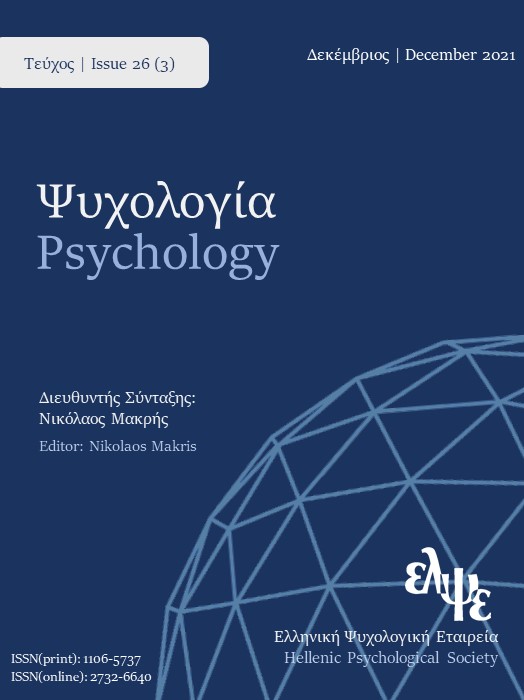Μελέτη της ορθογραφικής επεξεργασίας μέσω οφθαλμοκίνησης στην ελληνική γλώσσα

Περίληψη
Η παρούσα έρευνα εξέτασε τις διαφορές μεταξύ παιδιών με αναγνωστικές δυσκο- λίες (ΑΔ) και τυπικών αναγνωστών (3ης και 6ης τάξης) σε ένα έργο ορθογραφικής επεξεργασίας, μέσω της χρήσης τεχνικής οφθαλμοκίνησης. Οι τυπικοί αναγνώστες της 3ης δημοτικού αξιοποιήθηκαν επίσης ως ομάδα ιδίου αναγνωστικού επιπέδου προς τους συμμετέχοντες με αναγνωστικές δυσκολίες της 6ης τάξης. Στο έργο ορθογραφικής επεξεργασίας, οι συμμετέχοντες έπρεπε να δηλώσουν ποια από τις δύο λέξεις που παρουσιάζονταν ταυτόχρονα στην οθόνη αποτελούσε την ορθο- γραφημένη λέξη. Με τη χρήση ενός ανιχνευτή οφθαλμικών κινήσεων καταγράφηκαν δύο τύποι οφθαλμικών κινήσεων, οι κινήσεις προσήλωσης και οι σακκαδικές κινήσεις. Τα αποτελέσματα έδειξαν ότι οι συμμετέχοντες με αναγνωστικές δυσκολίες που φοιτούσαν στη Στ' τάξη έκαναν σημαντικά μεγαλύτερης διάρκειας κινήσεις προσήλωσης, μικρότερης διάρκειας αρχικές κινήσεις προσήλωσης και περισσότερες σακκαδικές κινήσεις σε σχέση με τους τυπικούς αναγνώστες, εύρημα που φανερώνει την έλλειψη εδραιωμένων ορθογραφικών ανα- παραστάσεων στο νοητικό τους λεξικό. Οι διαφορές μεταξύ των παιδιών που φοιτούσαν στη Γ' τάξη και μεταξύ των συμμετεχόντων με αναγνωστικές δυσκολίες που φοιτούσαν στη Στ' τάξη και της ομάδας ελέγχου που εξισώθηκε ως προς την αναγνωστική ηλικία δεν ήταν σημαντικές, υποδεικνύοντας ότι οι ομάδες χρησιμοποιούν παρόμοια στρατηγική για τον εντοπισμό της ορθογραφημένης λέξης. Η συζήτηση εστιάζεται στη σημασία της καταγραφής των οφθαλμικών κινήσεων ως μίας τεχνικής που μπορεί να προσφέρει σημαντική πληροφόρηση αναφορικά με τους μηχανισμούς που σχετίζονται με τα έργα της ανάγνωσης και ορθογραφίας.__
Λεπτομέρειες άρθρου
- Πώς να δημιουργήσετε Αναφορές
-
Φελλά Α., & Παπαδόπουλος Τ. Κ. (2018). Μελέτη της ορθογραφικής επεξεργασίας μέσω οφθαλμοκίνησης στην ελληνική γλώσσα. Ψυχολογία: το περιοδικό της Ελληνικής Ψυχολογικής Εταιρείας, 23(2), 182–201. https://doi.org/10.12681/psy_hps.23008
- Τεύχος
- Τόμ. 23 Αρ. 2 (2018)
- Ενότητα
- ΕΜΠΕΙΡΙΚΕΣ ΕΡΓΑΣΙΕΣ

Αυτή η εργασία είναι αδειοδοτημένη υπό το Creative Commons Attribution-ShareAlike 4.0 International License.
Το περιοδικό ΨΥΧΟΛΟΓΙΑ έχει υιοθετήσει μία πολιτική Platinum open-access. Τα έξοδα υποβολής, επεξεργασίας ή δημοσίευσης των εργασιών καλύπτονται από την Ελληνική Ψυχολογική Εταιρεία. Τα πνευματικά δικαιώματα των δημοσιευμένων εργασιών προστατεύονται από την άδεια 'Creative Commons Attribution-ShareAlike 4.0 International'. Οι Συγγραφείς διατηρούν τα Πνευματικά Δικαιώματα και χορηγούν στο περιοδικό το δικαίωμα της πρώτης δημοσίευσης. Η άδεια αυτή επιτρέπει σε τρίτους, να χρησιμοποιούν την εργασία σε οποιαδήποτε μορφή, με την προϋπόθεση της διατήρησης των διατυπώσεων που προβλέπονται στην άδεια σχετικά με την αναφορά στον αρχικό δημιουργό και την αρχική δημοσίευση στο περιοδικό ΨΥΧΟΛΟΓΙΑ. Επιπλέον, κάθε διανομή της εργασίας οφείλει να γίνεται με τους ίδιους όρους διανομής, δηλαδή με την ίδια άδεια Creative Commons.




